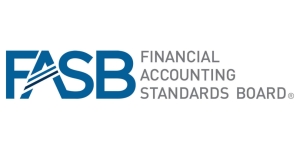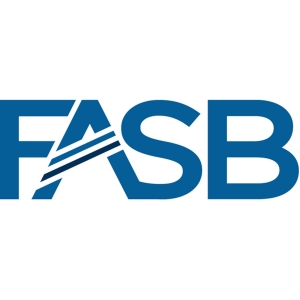عرض العناصر حسب علامة : FASB
يعدل مجلس FASB التدوين ليتوافق مع افصاحات لجنة SEC
يعدل مجلس معايير المحاسبة المالية FASB التدوين ليتوافق مع افصاحات لجنة الأوراق المالية والبورصات SEC.
معلومات إضافية
-
المحتوى بالإنجليزية
FASB issued an Accounting Standards Update (ASU)
that incorporates 14 SEC disclosure requirements into the FASB Accounting Standards Codification, a set of amendments covering a variety of topics that will affect a variety of reporting entities subject to GAAP.
The ASU's introductory section summarizes which among the 27 disclosures, issued in
SEC Release No. 33-10532, Disclosure Update and Simplification, have been incorporated into FASB codification. The SEC update was issued Aug. 17, 2018.
According to a FASB news release, the ASU amendments aim to "clarify or improve disclosure and presentation requirements of a variety of codification topics, allow users to more easily compare entities subject to the SEC's existing disclosures with those entities that were not previously subject to the requirements, and align the requirements in the codification with the SEC's regulations."
Regarding effective dates for the amendments, FASB noted in the news release:
"For entities subject to the SEC's existing disclosure requirements and for entities required to file or furnish financial statements with or to the SEC in preparation for the sale of or for purposes of issuing securities that are not subject to contractual restrictions on transfer, the effective date for each amendment will be the date on which the SEC removes that related disclosure from its rules. For all other entities, the amendments will be effective two years later. However, if by June 30, 2027, the SEC has not removed the related disclosure from its regulations, the amendments will be removed from the codification and not become effective for any entity."
يصدر مجلس معايير المحاسبة المالية فصلاً جديدًا من إطاره المفاهيمي
يقدم مجلس معايير معايير المحاسبة المالية تفاصيل التواصل مع المستثمرين
يسلط التقرير السنوي لمجلس معايير المحاسبة المالية عن جهوده لجمع واستخدام آراء المستثمرين في عملية وضع المعايير الخاصة به الضوء على الدور الرئيسي الذي لعبه المستثمرون في الإجراءات التي اتخذها مجلس الإدارة.
يتجه مجلس معايير المحاسبة المالية نحو معيار محاسبة القيمة العادلة للأصول المشفرة
سيستخدم قرار مجلس الإدارة المؤقت من قبل مجلس معايير المحاسبة المالية القيمة العادلة لقياس بعض الأصول المشفرة في التقارير المالية.
يسعى مجلس معايير المحاسبة المالية للحصول على مدخلات حول الفصل الجديد المقترح من الإطار المفاهيمي
مجلس معايير المحاسبة المالية يصدر فصلاً جديدًا مقترحًا لإطاره المفاهيمي يصف الكيان المسؤول عن إعداد التقارير.
معلومات إضافية
-
المحتوى بالإنجليزية
FASB seeks input on proposed new chapter of conceptual framework
FASB has issued a proposed new chapter for its Conceptual Framework that describes a reporting entity.
The proposed chapter would become Chapter 2 of FASB Concepts Statement No. 8, Conceptual Framework for Financial Reporting. The Conceptual Framework is a body of interrelated objectives and fundamentals that provides FASB with a tool as it sets standards. A Statement of Financial Accounting Concepts is nonauthoritative and does not establish or change generally accepted accounting principles.
The new chapter, according to a FASB release, would be similar to the rest of the framework in that it establishes concepts that the board would use in developing standards of financial accounting and reporting. It would provide the board with "a framework for developing standards that meet the objective of financial reporting and enhance the understandability of information for existing and potential investors, lenders, donors, and other resource providers of a reporting entity."
Stakeholders are asked to provide input on the characteristics of a reporting entity described in the proposed chapter. This includes a description of a reporting entity as "a circumscribed area of economic activities that can be represented by general purpose financial reports that are useful to existing and potential investors, lenders, and other resource providers in making decisions about providing resources to the entity."
It also describes the three features of a reporting entity:
Economic activities of the entity have been conducted.
Those economic activities can be distinguished from those of other entities.
The financial information in general-purpose financial reporting faithfully represents the economic activities of the entity in the circumscribed area and is useful in making decisions about providing resources to the entity.
يقترح مجلس معايير المحاسبة المالية تحسينات على التقارير القطاعية
أصدر مجلس معايير المحاسبة المالية (FASB) تحديثًا مقترحًا لمعايير المحاسبة (ASU) يوم الخميس والذي يهدف إلى تحسين الإفصاحات حول قطاعات الكيان العام التي يجب الإبلاغ عنها ومعالجة الطلبات المقدمة من المستثمرين والمخصصين الآخرين لرأس المال للحصول على معلومات أكثر تفصيلاً حول نفقات القطاع الواجب الإبلاغ عنها.
معلومات إضافية
-
المحتوى بالإنجليزية
FASB proposes improvements to segment reporting
FASB issued a proposed Accounting Standards Update (ASU) on Thursday that is intended to improve disclosures about a public entity's reportable segments and address requests from investors and other allocators of capital for more detailed information about a reportable segment's expenses.
FASB Chair Richard R. Jones said the proposed ASU, Segment Reporting (Topic 280): Improvements to Reportable Segment Disclosures, represents FASB's "most significant change to segment reporting since 1997."
"On the basis of our extensive stakeholder outreach, the proposed ASU would provide investors and other allocators of capital with valuable insights into significant segment expenses, expand segment disclosures reported in interim periods, and require disclosures for single-segment entities," Jones said in a news release.
According to FASB, the key amendments in the proposed ASU would:
Require that a public entity disclose, on an annual and interim basis, significant segment expenses that are regularly provided to the chief operating decision-maker (CODM) and included within each reported measure of segment profit or loss.
Require that a public entity disclose, on an annual and interim basis, an amount for other segment items by reportable segment and a description of its composition. The other segment items category is the difference between segment revenue less the significant expenses disclosed and each reported measure of segment profit or loss.
Require that a public entity provide all annual disclosures about a reportable segment's profit or loss and assets currently required by FASB ASC Topic 280, Segment Reporting, in interim periods.
Clarify that if the CODM uses more than one measure of a segment's profit or loss, at least one of the reported segment profit or loss measures (or the single reported measure if only one is disclosed) should be the measure that is most consistent with the measurement principles used in measuring the corresponding amounts in a public entity's consolidated financial statements.
Require that a public entity that has a single reportable segment provide all the disclosures required by the amendments in the proposed ASU and all existing segment disclosures in Topic 280.
مقالات المعالجة المحاسبية لإيرادات شركات ومكاتب تدقيق الحسابات وفقاً للمعيار الدولي لإعداد التقارير المالية 15
مقدمة عن مبادئ المحاسبة المقبولة عمومًا
معلومات إضافية
-
المحتوى بالإنجليزية
What is GAAP?
What does GAAP stand for? GAAP stands for generally accepted accounting principles. Generally accepted accounting principles are a set of rules, standards, and procedures certain businesses and organizations must follow.
GAAP in accounting helps businesses:
Organize financial information into accounting records
Summarize accounting records into financial statements
Disclose certain supporting financial information
Generally accepted accounting principles ensure businesses use a standard method to report financial information. Think of these principles as a rulebook that companies follow when creating financial statements (e.g., income statement, balance sheet, and cash flow statement).
Under GAAP, you need to structure your financial statements the same way from year to year. And, financial statement outlines should be the same as other businesses following GAAP.
These accounting principles determine how to create financial statements. The standard format makes it easy for investors, lenders, and auditors to gather information about your business.
With GAAP, you must also use accrual accounting. Accrual accounting is the most complex method that uses more advanced accounts, such as accounts payable and long-term liabilities.
What principles does the GAAP include?
GAAP includes a wide range of topics, including financial statement presentation, assets, liabilities, equity, revenue, expenses, fair value, nonmonetary transactions, and so on.
The GAAP has 10 principles—the Principle of:
Regularity: Businesses must follow all specific rules and regulations.
Consistency: Consistently apply the same accounting standards to your entire accounting process.
Sincerity: Provide an accurate and impartial depiction of your business’s financial situation.
Permanence of Methods: The procedures you use in financial reporting should be consistent, making it easy to compare financial information.
Non-compensation: Businesses must report positives and negatives and be completely transparent about their finances. Report both assets and liabilities separately.
Prudence: Be prudent, or conservative, when deciding which accounting methods to use.
Continuity: Conduct accounting based on the assumption that your business will continue to operate.
Periodicity: Report financial information at regular intervals.
Materiality: Fully disclose all financial data and accounting information in financial reports.
Utmost Good Faith: Honestly record transactions and collect financial data.
In addition to the above, you must also follow these four principles while creating financial statements:
Recognition: Your financial statements should accurately show all of your company’s assets, liabilities, revenue, and expenses.
Measurement: Financial statements should measure and show financial results in accordance with GAAP standards.
Presentation: For financial statements, you should include an income statement, a balance sheet, a cash flow statement, and a statement of shareholder’s equity.
Disclosure: Financial statements should include any necessary notes to fully explain the financial information you provide.
مقدمة في المحاسبة المالية
معلومات إضافية
-
المحتوى بالإنجليزية
Introduction to Financial Accounting
Financial accounting is a specialized branch of accounting that keeps track of a company's financial transactions. Using standardized guidelines, the transactions are recorded, summarized, and presented in a financial report or financial statement such as an income statement or a balance sheet.
Companies issue financial statements on a routine schedule. The statements are considered external because they are given to people outside of the company, with the primary recipients being owners/stockholders, as well as certain lenders. If a corporation's stock is publicly traded, however, its financial statements (and other financial reportings) tend to be widely circulated, and information will likely reach secondary recipients such as competitors, customers, employees, labor organizations, and investment analysts.
It's important to point out that the purpose of financial accounting is not to report the value of a company. Rather, its purpose is to provide enough information for others to assess the value of a company for themselves.
Because external financial statements are used by a variety of people in a variety of ways, financial accounting has common rules known as accounting standards and as generally accepted accounting principles (GAAP). In the U.S., the Financial Accounting Standards Board (FASB) is the organization that develops the accounting standards and principles. Corporations whose stock is publicly traded must also comply with the reporting requirements of the Securities and Exchange Commission (SEC), an agency of the U.S. government.
Confused? Send Feedback
Double Entry and Accrual Accounting
At the heart of financial accounting is the system known as double entry bookkeeping (or "double entry accounting"). Each financial transaction that a company makes is recorded by using this system.
The term "double entry" means that every transaction affects at least two accounts. For example, if a company borrows $50,000 from its bank, the company's Cash account increases, and the company's Notes Payable account increases. Double entry also means that one of the accounts must have an amount entered as a debit, and one of the accounts must have an amount entered as a credit. For any given transaction, the debit amount must equal the credit amount. (To learn more about debits and credits, visit our Explanation of Debits & Credits.)
The advantage of double-entry accounting is this: at any given time, the balance of a company's asset accounts will equal the balance of its liability and stockholders' (or owner's) equity accounts. (To learn more on how this equality is maintained, visit our Explanation of Accounting Equation.)
Financial accounting is required to follow the accrual basis of accounting (as opposed to the "cash basis" of accounting). Under the accrual basis, revenues are reported when they are earned, not when the money is received. Similarly, expenses are reported when they are incurred, not when they are paid. For example, although a magazine publisher receives a $24 check from a customer for an annual subscription, the publisher reports as revenue a monthly amount of $2 (one-twelfth of the annual subscription amount). In the same way, it reports its property tax expense each month as one-twelfth of the annual property tax bill.
By following the accrual basis of accounting, a company's profitability, assets, liabilities and other financial information is more in line with economic reality. (To learn more about the accrual basis of accounting, visit our Explanation of Adjusting Entries.)
Confused? Send Feedback
Accounting Principles
If financial accounting is going to be useful, a company's reports need to be credible, easy to understand, and comparable to those of other companies. To this end, financial accounting follows a set of common rules known as accounting standards or generally accepted accounting principles (GAAP, pronounced "gap").
GAAP is based on some basic underlying principles and concepts such as the cost principle, matching principle, full disclosure, going concern, economic entity, conservatism, relevance, and reliability. (To learn more about the basic principles, visit our Explanation of Accounting Principles.)
GAAP, however, is not static. It includes some very complex standards that were issued in response to some very complicated business transactions. GAAP also addresses accounting practices that may be unique to particular industries, such as utility, banking, and insurance. Often these practices are a response to changes in government regulations of the industry.
GAAP includes many specific pronouncements as issued by the Financial Accounting Standards Board (FASB, pronounced "fas-bee"). The FASB is a non-government group that researches current needs and develops accounting rules to meet those needs. (To learn more about FASB and its accounting pronouncements, visit our www.FASB.org.)
In addition to following the provisions of GAAP, any corporation whose stock is publicly traded is also subject to the reporting requirements of the Securities and Exchange Commission (SEC), an agency of the U.S. government. These requirements mandate an annual report to stockholders as well as an annual report to the SEC. The annual report to the SEC requires that independent certified public accountants audit a company's financial statements, thus giving assurance that the company has followed GAAP.
Confused? Send Feedback
Financial Statements
Financial accounting generates the following general-purpose, external, financial statements:
Income statement (sometimes referred to as "results of operations" or "earnings statement" or "profit and loss [P&L] statement")
Statement of comprehensive income
Balance sheet (sometimes referred to as "statement of financial position")
Statement of cash flows (sometimes referred to as "cash flow statement")
Statement of stockholders' equity
Income Statement
The income statement reports a company's profitability during a specified period of time. The period of time could be one year, one month, three months, 13 weeks, or any other time interval chosen by the company.
The main components of the income statement are revenues, expenses, gains, and losses. Revenues include such things as sales, service revenues, and interest revenue. Expenses include the cost of goods sold, operating expenses (such as salaries, rent, utilities, advertising), and nonoperating expenses (such as interest expense). If a corporation's stock is publicly traded, the earnings per share of its common stock are reported on the income statement. (To learn more about the income statement, visit our Explanation of Income Statement.)
Statement of Comprehensive Income
The statement of comprehensive income covers the same period of time as the income statement, and consists of two major sections:
Net income (taken from the income statement)
Other comprehensive income (adjustments involving foreign currency translation, hedging, and postretirement benefits)
The sum of these two amounts is known as comprehensive income.
The amount of other comprehensive income is added/subtracted from the balance in the stockholders' equity account Accumulated Other Comprehensive Income.
Balance Sheet
The balance sheet is organized into three parts: (1) assets, (2) liabilities, and (3) stockholders' equity at a specified date (typically, this date is the last day of an accounting period).
The first section of the balance sheet reports the company's assets and includes such things as cash, accounts receivable, inventory, prepaid insurance, buildings, and equipment. The next section reports the company's liabilities; these are obligations that are due at the date of the balance sheet and often include the word "payable" in their title (Notes Payable, Accounts Payable, Wages Payable, and Interest Payable). The final section is stockholders' equity, defined as the difference between the amount of assets and the amount of liabilities. (To learn more about the balance sheet, visit our Explanation of Balance Sheet.)
Statement of Cash Flows
The statement of cash flows explains the change in a company's cash (and cash equivalents) during the time interval indicated in the heading of the statement. The change is divided into three parts: (1) operating activities, (2) investing activities, and (3) financing activities.
The operating activities section explains how a company's cash (and cash equivalents) have changed due to operations. Investing activities refer to amounts spent or received in transactions involving long-term assets. The financing activities section reports such things as cash received through the issuance of long-term debt, the issuance of stock, or money spent to retire long-term liabilities. (To learn more about the statement of cash flows, visit our Explanation of Cash Flow Statement.)
رسالة ماجستير: نموذج مقترح لقياس أثر تطبيق معيار الإيرادات من العقود مع العملاء من منظور ضريبي لتحقيق التنمية المستدامة
يعتبر الإيراد عنصر هام من عناصر قائمة الدخل، حيث أن الإعتراف بالإيراد يؤثر على مجمل الربح وبالتالى يکون له تأثر على صافى الربح.
معلومات إضافية
- البلد مصر










